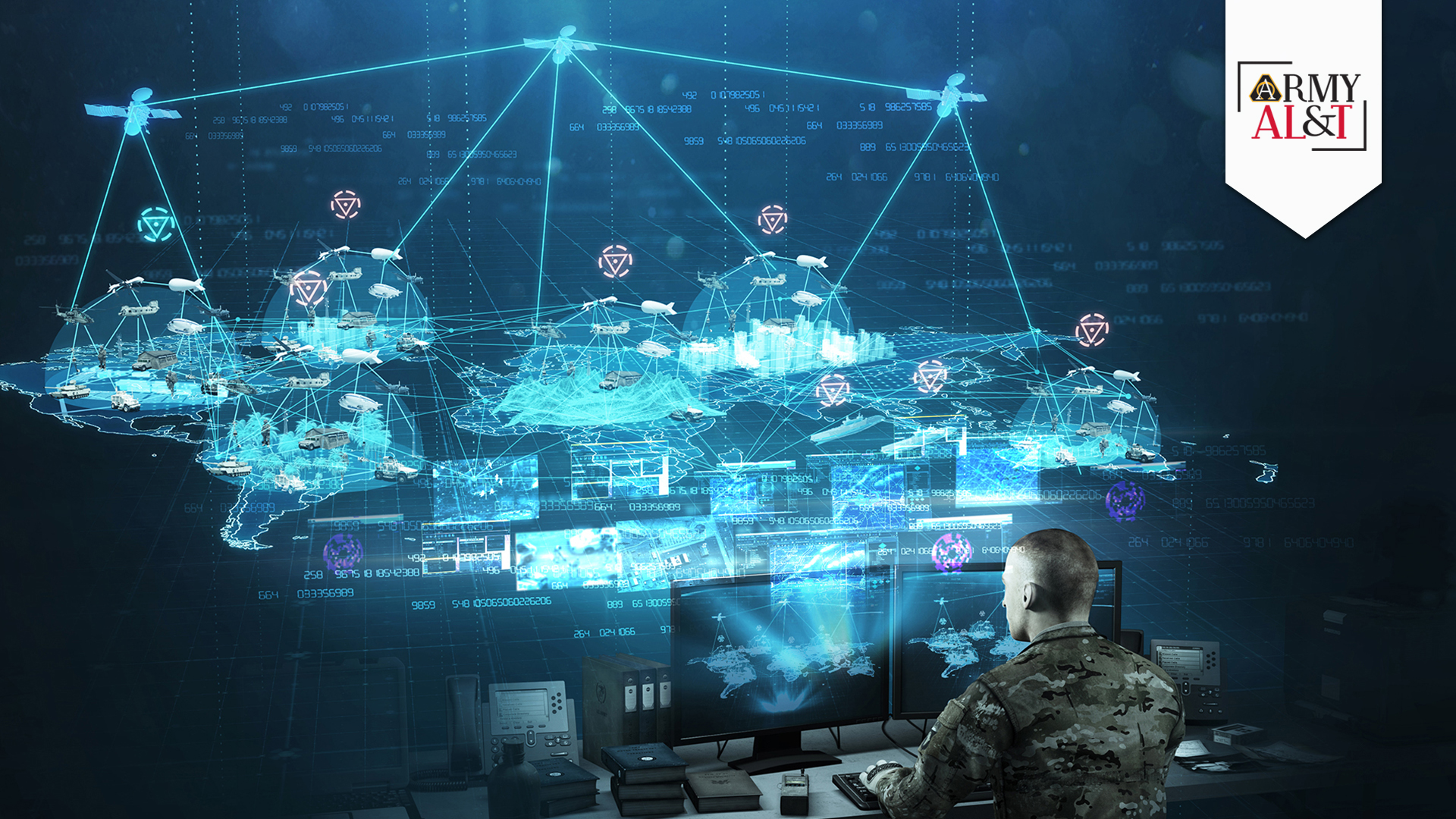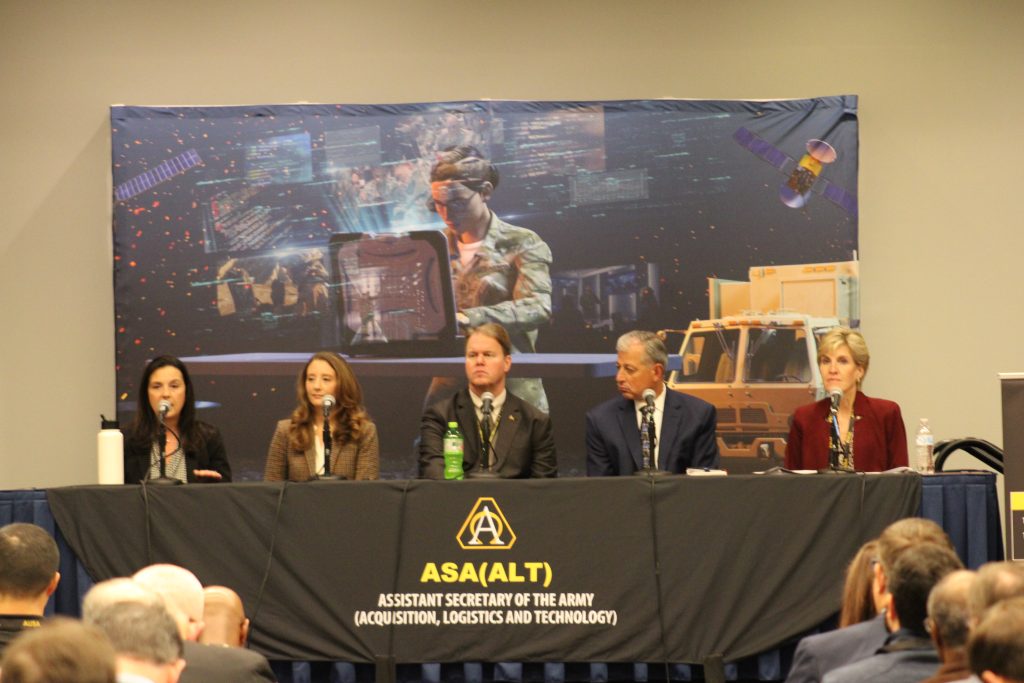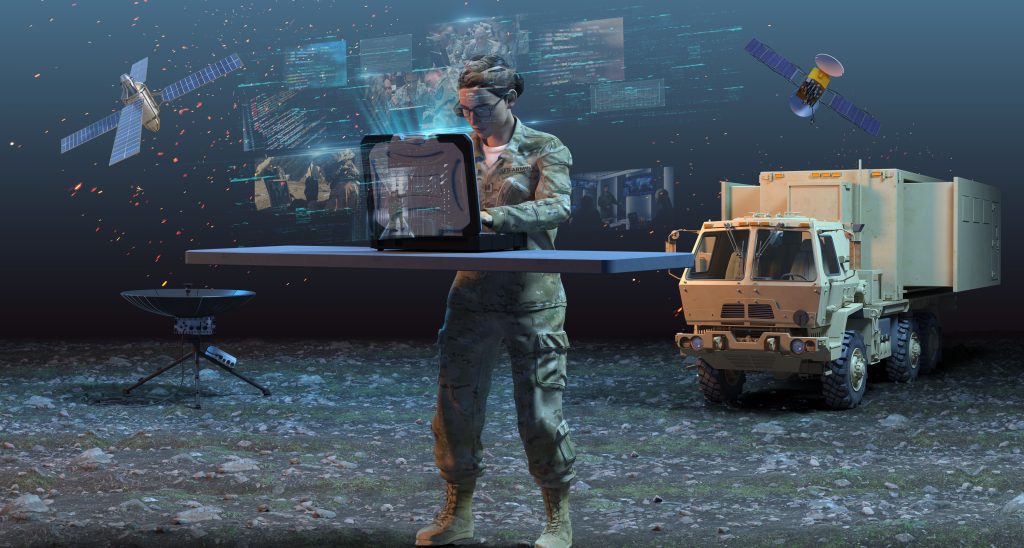
MODERN METHODOLOGIES: Modern software development methodologies promise enhanced capabilities by prioritizing rapid delivery of solutions, adaptability and collaboration with users, ensuring that software products are not only functional but also aligned with capability gaps and user needs. (Graphic by the Program Executive Office for Intelligence, Electronic Warfare and Sensors)
How the Army is embracing modern software development and acquisition practices to maintain a competitive edge.
by Margaret Boatner
More than ever before, the ability to rapidly develop and deploy software is a national security imperative. In the past, software typically served as an enabler of hardware systems and weapons platforms. Today, however, software underpins our mission-critical capabilities. It drives our weapons, business and training systems and is embedded into the processes that make DOD function. In the past 10 years, the number of our systems reliant on software has increased nearly 30%. While technology and software capabilities have advanced significantly in recent years, the Army’s processes by which software is developed and acquired have not similarly matured. As the Army moves into this software-intensive world, it’s critical that its institutional policies and processes evolve to support agile and iterative development of software. With the release of Army Directive 2024-02, “Enabling Modern Software Development & Acquisition Practices,” the Army has taken a major step in this evolution.
THE SOFTWARE CHALLENGE
Software is a key component of nearly everything the Army operates and uses. This includes weapon systems across all capability portfolios, from missiles and air defense like the Army’s Integrated Air and Missile Defense program, to ground combat vehicles like the Robotic Combat Vehicle. Our business systems—or information systems—are similarly driven by software. For example, the Army uses the Global Combat Support System to manage its logistics operations and the Army Contract Writing System to write and manage contracts across the Army. The same reliance on software extends to the “back of house” processes that the Army depends on to operate, such as the Defense Travel System, which is used to plan and schedule travel.
Our adversaries are similarly reliant on software-driven capabilities. In recent years, the Chinese government and defense industry have been pursuing significant investments in robotics, swarming, autonomous operations, artificial intelligence, machine learning and other novel capabilities. It’s clear from these investments that China—the United States’ pacing threat—is seeking to use software-driven technologies to enhance its national security and military capabilities. China, and others, will use such technologies to target our military facilities, weapons systems and assets, Soldiers, networks and critical infrastructure.
The challenge facing the Army now is clear: The hardware advantage that American systems have long enjoyed is becoming less determinative of a military advantage; software is leveling the playing field. The competitor that can rapidly develop and iteratively upgrade its software-defined capabilities will have an advantage in future conflicts. To achieve this advantage, the Army must pivot away from historical, waterfall software development approaches and adopt the modern software development practices that will allow us to rapidly respond to emerging technologies and threats in an ever-changing global landscape.

CONTINUOUS INTEGRATION, DELIVERY: The author, center, addresses audience members during a digital engineering presentation at the Association of the United States Army Annual Meeting and Exposition in Washington on Oct. 11, 2023. (Photo by Alexander Baquilod, Office of the ASA(ALT))
MODERN METHODOLOGIES VS. INSTITUTIONAL ARMY PROCESSES
Modern software development methodologies promise enhanced capabilities by prioritizing rapid delivery of solutions, adaptability and collaboration with users, ensuring that software products are not only functional but also aligned with capability gaps and user needs. (See sidebar, “What is Modern Software Development?”) These approaches are broadly adopted by the private sector and have been widely recognized as best practices in the field of software development since the early 2000s.
|
WHAT IS MODERN SOFTWARE DEVELOPMENT? Modern software development is an iterative approach to managing software development projects that focuses on continuous releases and customer feedback. Modern methodologies include continuous integration/continuous delivery; agile; lean; and DevSecOps (development, security and operations) practices. The underlying principles of modern software development can be explained by three key pillars:
|
|
CASE FOR CHANGE
|
In contrast to the private sector, software development in the Army has traditionally used the waterfall approach, which is linear and sequential, requiring that each phase—from requirements development to deployment—be completed before the next can begin. This often means that changes are costly, time-intensive and hard to implement once development starts. The Army’s use of the waterfall approach is, in part, driven by the Army’s underlying, institutional processes, which were put in place in the Cold War era and were designed for the development of the hardware-based capabilities that were so critical at the time. As a result, software has historically been acquired, developed and managed much like hardware.
Let’s look at an example of the process our software-intensive systems are subject to under this waterfall approach. At the earliest phase, requirements must be documented and approved. Currently, requirements are written in a very detailed and prescriptive manner (often totaling hundreds of pages in length), can take a significant period of time to be approved and are not frequently reassessed based on user feedback. This can result in inflexible requirements that cannot easily be changed to respond to user needs. Next, these systems enter the acquisition process. Until the creation of the Software Acquisition Pathway in October 2020, software-intensive programs were forced to comply with an acquisition process designed for hardware systems, which did not support the flexibility and adaptability required by modern software development. As programs progress through development, numerous test and evaluation activities occur at rigid points in the process and are completed in a sequential manner. And often, tests that are done by a vendor or other entity are repeated, adding more time and cost. Lastly, once development concludes and systems are deployed, they historically transition to sustainment, where they are maintained, with only minor updates, until they are disposed of. This is counter to the premise that “software is never done” and limits the ability of our software-intensive systems to be continually refined and improved to meet emerging needs.
This approach results in software development that takes years to complete, with big-bang capability releases often separated by years, and software solutions that do not always account for changing user needs and threats. Given the evolution of technology in the last several decades and the increasingly software-defined environment we are operating in, this process no longer meets the timely demands of our warfighters. Importantly, adoption of modern software practices is not a technical challenge—recall that the private sector has been doing this for decades. Rather, the Army’s challenge is adjusting its longstanding processes to accommodate these methodologies.

PANEL DISCUSSION: Boatner, second from left, joined a panel of experts to speak about the continuous integration and continuous delivery model in Washington in October 2023. From left is Jennifer Swanson, deputy assistant secretary of the Army for data, engineering and software; Willie B. Nelson, deputy to the commanding general, United States Army Futures Command; James Amato, executive technical director and deputy to the commander, United States Army Test and Evaluation Command; and Megan Dake, deputy assistant secretary of the Army for procurement. (Photo by Alexander Baquilod, Office of the ASA(ALT))
POLICY AND REFORM INITIATIVES
Recognizing the need to reform, the Army launched a comprehensive review of its institutional processes to determine where changes are needed to promote modern software development and acquisition. As a result, the Army released Army Directive 2024-02, “Enabling Modern Software Development & Acquisition Practices,” on March 9, 2024. This new policy represents one of the first significant efforts across the DOD to comprehensively adjust processes to align with private sector best practices. The policy is comprised of 12 reform initiatives, targeting processes across the entire development life cycle. The most significant new requirements of the policy are summarized below:
- Establish a flexible requirements process. Under the new policy, requirements for software development programs and efforts must be written at a high level, prioritized and reassessed, and refined over time based on user feedback. This allows requirements to change based on evolving technologies and the changing threat landscape.
- Ensure continuous user-developer teaming. Under the new policy, users are required to be continuously involved throughout the software development life cycle through user-developer teams. These teams will identify and prioritize requirements, determine tradeoffs of software features and assess user value. This ensures software solutions are iteratively developed in line with user needs.
- Tailor processes to enable agile development. The policy requires acquisition and contracting approaches that allow for the rapid iteration of software solutions. This includes maximizing use of the Software Acquisition Pathway—the acquisition pathway designed for agile software development—alone or in conjunction with other pathways; employing contract strategies that increase flexibility and adaptability, including modular contracting or multiple award contracts; and using contract types such as cost reimbursement, labor hour, incentive and/or hybrid that allow for refinement of the requirements based on the evolution of the software solution and changing user needs.
- Establish a Contracting Center of Excellence for Digital Capabilities. To ensure the Army’s contracting strategies provide flexibility, incentivize modern development approaches and ensure vendor accountability, the policy designates the Army Contracting Command at Aberdeen Proving Ground, Maryland, as the Contracting Center of Excellence for Digital Capabilities. The center will be responsible for executing select contracts and for promulgating best practices across Army contracting organizations to ensure a consistent approach.
- Establish the Software Management and Response Team (SMART). Successful execution of software development efforts requires personnel with expertise and experience in modern software development practices. To ensure this type of expertise is available at scale to support software development efforts underway across the Army, the SMART will be established within the Office of the Chief Information Officer. The team will provide distributed support to, and conduct peer reviews of, software development efforts executed outside of the program executive offices, including those executed by Army commands, Army service component commands and other Army organizations.
- Manage software development efforts not subject to formal acquisition oversight. The new policy implements several new requirements to ensure the synchronization of software development efforts executed across the Army, including those executed by Army commands, Army service component commands and other Army organizations. This includes directing that requirements for these software efforts be reported to Army headquarters for review and prioritization, requiring these activities to be executed through select contracting organizations, and mandating enhanced reporting of the status and progress of these software efforts.
- Streamline software test requirements. Proper test and evaluation of our software is important to ensure reliable and secure software. However, current processes often lead to duplicative testing and extended timelines. To address this, the new policy will reduce duplicative test requirements by employing test data reciprocity to the maximum extent possible. Moving forward, government testing will only be required when reliable data from other sources—such as the vendor—is not available. Additionally, test requirements will be tailored based on the significance of new capabilities and/or features.
- Modernize cybersecurity approaches. The policy requires that current cybersecurity approaches be modernized. This includes complying with current DOD risk management framework to obtain an authority to operate (ATO), an approval required for an information technology solution to operate on the government network. Processes required to comply with the framework will be automated to the maximum extent possible to decrease the time, workload and costs required by the current manual process. The Army will also establish ATO reciprocity across Army organizations to streamline requirements and accelerate capability deployment and will seek ATO reciprocity from the Office of the Secretary of Defense and the other services. Finally, the Army will initiate a transition from the traditional, static ATO to continuous ATO processes to enable real-time cybersecurity monitoring.
- Modernize approach to software cost estimating. The Army will adopt industry best practices for developing software cost estimates that support modern software development approaches.
- End traditional software sustainment. Recognizing that software is not developed, tested, procured, operated and sustained sequentially, the Army will transition from the traditional sustainment model to a continuous integration/continuous delivery model, wherein software is continuously and iteratively developed and upgraded throughout its life cycle.
- Enable data-centric interoperability. Currently, the Army has a complicated data environment, in which data is often stovepiped across various communities and systems, limiting its ability to make data-informed decisions. The Army is updating the Army Data Plan and related policies to enable data interoperability in and between environments. The Office of the Assistant Secretary of the Army for Acquisition, Logistics and Technology will define a data reference architecture that will help to connect the various data systems and services, enabling data to be easily discovered, accessed and consumed by users. This will allow the Army to more effectively and efficiently handle and use its vast amounts of data.
- Enhance talent management. None of the initiatives outlined above can be successful without the right talent. Under the new policy, the Army will be more deliberate in attracting, utilizing and training talent skilled in modern software development practices. Select organizations across the requirements, acquisition, contracting, sustainment, testing and cyber communities will develop plans to upskill their respective workforces on modern software development practices. The Army is also exploring innovative ways to attract and retain technical talent, including use of special pay scales, and will develop career progression maps to empower career development for the digital workforce that exists across career fields.

SOLUTIONS ACROSS SYSTEMS: Software is a key component in nearly everything the Army operates and uses. This includes weapon systems across all capability portfolios from missiles and air defense, such as the Army’s Integrated Air and Missile Defense program. (Graphic by the Program Executive Office for Intelligence, Electronic Warfare and Sensors)
CONCLUSION
Developing software faster, more efficiently and with greater impact will allow us to better respond to evolving technologies, challenges and threats, sharpening our competitive advantage and ensuring that we can deliver critical capabilities to Soldiers. Implementing the reforms contained within Army Directive 2024-02 will help the Army achieve this objective by fundamentally changing how it develops and acquires software.
For more information on the new policy and reform initiatives, go to https://armypubs.army.mil/epubs/DR_pubs/DR_a/ARN40433-ARMY_DIR_2024-02-000-WEB-1.pdf.
MARGARET BOATNER serves as the deputy assistant secretary of the Army for strategy and acquisition reform. In this role, she is the principal adviser to the assistant secretary of the Army for acquisition, logistics and technology for the design and implementation of acquisition policy and related reform initiatives. She holds an MBA from Georgetown University and a B.S. in business administration from the University of Mary Washington. She also serves on the College of Business Executive Advisory Board at the University of Mary Washington.







